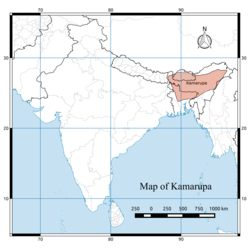
Back শালস্তম্ভ ৰাজবংশ Assamese ম্লেচ্ছ রাজবংশ Bengali/Bangla Dinastia Mlechchha Catalan Млеччха (династия) Russian மிலேச்ச அரசமரபு Tamil
Kamarupa Kingdom Mlechchha dynasty | |||||||||
|---|---|---|---|---|---|---|---|---|---|
| 650 CE–900 CE | |||||||||
 Kamarupa Map | |||||||||
| Capital | Harruppesvar (present-day Tezpur) | ||||||||
| Religion | Shaktism, Polytheism | ||||||||
| Government | Monarchy | ||||||||
| Maharajadhiraja | |||||||||
• c. 650 - c. 670 | Salasthamba | ||||||||
• c. 815 – c. 832 | Harjjaravarman | ||||||||
• c. 890 – c. 900 | Tyagasimha | ||||||||
| Historical era | Classical India | ||||||||
• Established | 650 CE | ||||||||
• Disestablished | 900 CE | ||||||||
| |||||||||
| Part of a series on the |
| History of Kamarupa |
|---|
 |
| Ruling dynasties |
| Part of a series on the |
| History of Assam |
|---|
 |
| Categories |

Kamakhya Temple is the central shrine of Kamarupa[1]
The Mlechchha dynasty (c. 650 - 900) ruled Kamarupa from their capital at Harruppesvar in present-day Tezpur, Assam, after the fall of the Varman dynasty.[2] According to historical records, there were twenty one rulers in this dynasty, but the line is obscure and names of some intervening rulers are not known.[3] Like all other Kamarupa dynasties a semi-mythical lineage from Narakasura was constructed to accord legitimacy to their rule.[4] The Mlechchha dynasty in Kamarupa was followed by the Pala kings. The dynasty is unrelated to the previous Varman dynasty.[5]
- ^ (Shin 2010:8):"Along with the inscriptional and literary evidence, the archaeological remains of the Kamakhya temple, which stands on top of the Nilacala, testify that the Mlecchas gave a significant impetus to construct or reconstruct the Kamakhya temple."
- ^ (Sen 1999:P.304)
- ^ (Ray 1931:242)
- ^ Shin 2011, p. 183.
- ^ (Shin 2016:127):"From a close reading of the royal genealogy, it is apparent that there was no unilineal development of dynasties and definite connection among them. In fact, the Mlecchas and the Pālas denied the validity of previous dynasty for claiming their own legitimacy and the character and identity of progenitor, Naraka, were continuously re-formulated according to the socio-political changes."